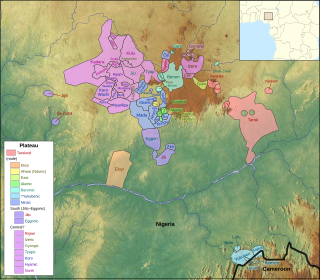Related Research Articles

The forty or so Plateau languages are a tentative group of Benue–Congo languages spoken by 15 million people on the Jos Plateau, Southern Kaduna, Nasarawa State and in adjacent areas in central Nigeria.
Tarok is an agrarian society in the hills and on the plains southeast of Plateau State, Middle Belt, Nigeria.

There are over 525 native languages spoken in Nigeria. The official language and most widely spoken lingua franca is English, which was the language of Colonial Nigeria. Nigerian Pidgin – an English-based creole – is spoken by 30 million people in Nigeria.
Chakato is a West Chadic language spoken in Plateau State, Nigeria. It was identified by Roger Blench in 2016. It is spoken by about 500 people in one village, Dokan Tofa, which is located on the Jos-Shendam road in Plateau State. Blench (2017) suggests that Chakato may be related to spurious records of the Jorto language. Chakato speakers claim that their language is closely related to Goemai.
Pan is an Afro-Asiatic dialect cluster spoken in Plateau State, Nigeria.

Ngas, or Angas, is an Afro-Asiatic language spoken in Plateau State, Nigeria. The language has two dialects: Hill Angas and Plain Angas. Retired General Yakubu Gowon is a prominent Nigerian who is of Ngas extraction.
Koenoem is an Afro-Asiatic language spoken in Plateau State, Nigeria. It is spoken in about 6 villages east of the Panyam-Shendam road.
Pyapun is an Afro-Asiatic language spoken in Plateau State, Nigeria. It is spoken in about 10 villages east of the Panyam-Shendam road.
Tarok is a regionally important Plateau language in the Langtang area of southeast Plateau State, Nigeria, where it serves as a local lingua franca. Blench (2004) estimates around 150,000 speakers.
The five Tarokoid languages are a branch of the Plateau family spoken in central Nigeria, just north of the middle reaches of the Benue River. Tarok itself has 300,000 speakers, with Pe and Sur about 5,000 each. Yangkam is severely endangered, being spoken by around fifty elderly men.
Alumu is a Plateau language spoken by approximately 7,000 people in Nassarawa State, Nigeria. It has lost the nominal affix system characteristic of the Niger–Congo family.
Yiwom (Ywom), also known as Gerka or Gerkawa by the Hausa, is a Chadic (Afro-Asiatic) language spoken in Plateau State, Nigeria.
Ahwai, also called the Ndunic languages, is a Plateau language cluster spoken to the southwest of Fadan Karshi in Sanga LGA, Kaduna State, Nigeria. Most villages are located at the foot of the Ahwai Mountains in Kaduna State.
Toro, also known as Turkwam, is a Plateau language of Nigeria. It has lost the nominal affix system characteristic of the Niger–Congo family.
Cara, also called Teriya after the village it is spoken in, is a small Plateau language of central Nigeria. Cara is spoken by about 3,000 people in Teriya village, Bassa, Plateau State, Nigeria.
The Kamuku languages are a branch of the Kainji languages spoken by the Kamuku people of Niger State, western Nigeria, mostly in Mariga and Rafi LGAs.
Sur–Myet, also known as kuSur (Nsur), Tapshin, or Myet, is a minor Plateau language of Bauchi and Plateau states, Nigeria. There are two closely related dialects, Súr and Myet.
Yangkam (Yankam), or Bashar (Basherawa), is a moribund Plateau language of Nigeria. It is located to the west of Bashar town in Plateau State.

The Ron, Ronic or Ron–Fyer languages, group A.4 of the West Chadic branch of the Afro-Asiatic language family, are spoken in Plateau State, north-central Nigeria.
Nteng is a West Chadic language spoken in Plateau State, Nigeria. Nteng is spoken in the villages of Nteng, Geer, Ɗok, Kelaghal, Lool, Kwaki, Jekmorop, and Gorom, with Gorom being a primarily Bwal-speaking village. Roger Blench (2017) estimates that there are 2,000 speakers as of 2017.
References
- ↑ Pe at Ethnologue (18th ed., 2015) (subscription required)
- 1 2 3 4 5 6 Blench, Roger. 2023. The Pe language of Central Nigeria and its affinities . Cambridge: Kay Williamson Educational Foundation.
- ↑ A Sociolinguistic Profile of the Pye (Pe) [pai] Language of Plateau State, Nigeria .
- ↑ CAPRO. 2004. A harvest of Peace. An ethnic survey of Plateau State. Jos: CAPRO Research Office.
- ↑ Blench, Roger. 2004. Tarok and related languages of east-central Nigeria.